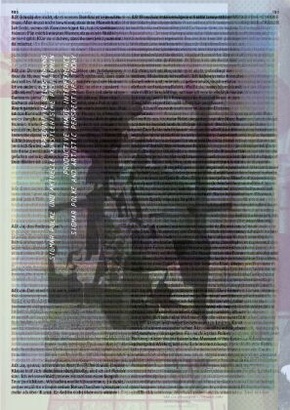
Produktive Bildstorung. - Sigmar Polke und aktuelle künstlerische Positionen (Deutsch / Englisch)
| Verlag | Distanz Verlag |
| Auflage | 2021 |
| Seiten | 238 |
| Format | 21,2 x 2,0 x 29,8 cm |
| Großformatiges Paperback. Klappenbroschur | |
| Gewicht | 745 g |
| ISBN-10 | 3954764253 |
| ISBN-13 | 9783954764259 |
| Bestell-Nr | 95476425A |
Der Pionier der Bildstorung
Langst leben wir mit dem Bewusstsein, dass wir unseren Augen nicht trauen konnen und dass Bilder, ob manuell oder technisch hergestellt, die Realitat weniger abbilden als sie vielmehr maßgeblich selbst mitgestalten - Ubertragungsfehler, Qualitatsverluste, Hacks und andere Storungen inbegriffen. Als Sigmar Polke (geb. 1941 in Oels, Niederschlesien; gest. 2010 in Koln) Anfang der 1960er-Jahre an der Kunstakademie Düsseldorf studierte, richtete sich sein Interesse schnell auf die massenmedial verbreiteten Bilder seiner Zeit. Das Ubertragen und Storen, das Transformieren und Umcodieren dieser Bilder wurden in seinen Rasterbildern zum Motiv und frühen Markenzeichen. Auch für eine gegenwartige Generation von Kunstschaffenden stellt die Bildstorung einen produktiven Ausgangspunkt dar. Zum 80. Geburtstag von Sigmar Polke realisiert die Anna Polke-Stiftung gemeinsam mit der Kunsthalle Düsseldorf ein Ausstellungsprojekt, kuratiert von Kathrin Barutzk i und Nelly Gawellek (beide Anna Polke-Stiftung) mit Gregor Jansen (Kunsthalle Düsseldorf). Unter dem Titel Produktive Bildstorung werden Werke Polkes mit Arbeiten von Kerstin Bratsch, Phoebe Collings-James, Raphael Hefti, Camille Henrot, Trevor Paglen, Seth Price, Max Schulze und Avery Singer zusammengebracht.
Der Katalog erortert erstmals einen der zentralen Aspekte im Gesamtwerk Polkes und knüpft diesen an die gegenwartige Kunstproduktion an. Der auf Appropriation und Sampling basierende Umgang mit bereits existierenden Bildern und ihren kulturellen wie politischen Implikationen wird in Texten von Kathrin Barutzki, Katharina Bruns, Nelly Gawellek, Alicia Holthausen, Gregor Jansen, Charlotte Lang, Janice Mitchell und Sophia Stang behandelt. In Gesprachen zwischen Avery Singer und Albert Oehlen sowie Raphael Hefti und Bice Curiger, durch Werkbegegnungen und eigens für das Buch geschaffene Beitrage der teilnehmenden Künstler_innen entsteht ein sich von Polke aus offnendes Panorama zum Umgang mit den Bild- und Zeit-Kontexten, die unsere Sicht auf die Welt formen.
The Pioneer of Image Interference
We have long lived with the awareness that we cannot trust our eyes-that pictures, whether manufactured or technically generated, do not so much depict reality as rather play a key role in shaping it, transmission errors, losses of quality, hacks, and other disruptions included. Studying at the Dusseldorf Academy of Fine Arts in the early 1960s, Sigmar Polke (b. Oels, Lower Silesia, 1941; d. Cologne, 2010) soon took an interest in the mass-media imagery of his time. The replication and adulteration, transformation and recoding of these images became the motif of his raster-dot paintings and an early trademark of his art. Like Sigmar Polke before them, a generation of contemporary artists now finds inspiration in image interference. To mark his 80th birthday, the Anna Polke Foundation collaborates with Kunsthalle Dusseldorf to realize an exhibition curated by Kathrin Barutzki and Nelly Gawellek (both Anna Polke Foundation) with Gregor Jansen (Kunsthalle Dusseldorf). Titled Productive Image Interference, it presents Polke's works in dialogue with contributions by Kerstin Bratsch, Phoebe Collings- James, Raphael Hefti, Camille Henrot, Trevor Paglen, Seth Price, Max Schulze, and Avery Singer.
The catalogue is the first book dedicated to an in-depth discussion of a central aspect of Polke's oeuvre, drawing connections to contemporary art production. The visual practice of appropriating and sampling existing images with their cultural and political implications is discussed in essays by Kathrin Barutzki, Katharina Bruns, Nelly Gawellek, Alicia Holthausen, Gregor Jansen, Charlotte Lang, Janice Mitchell, and Sophia Stang. In conversations between Avery Singer and Albert Oehlen as well as Raphael Hefti and Bice Curiger, through work encounters and contributions created especially for the book by the p
